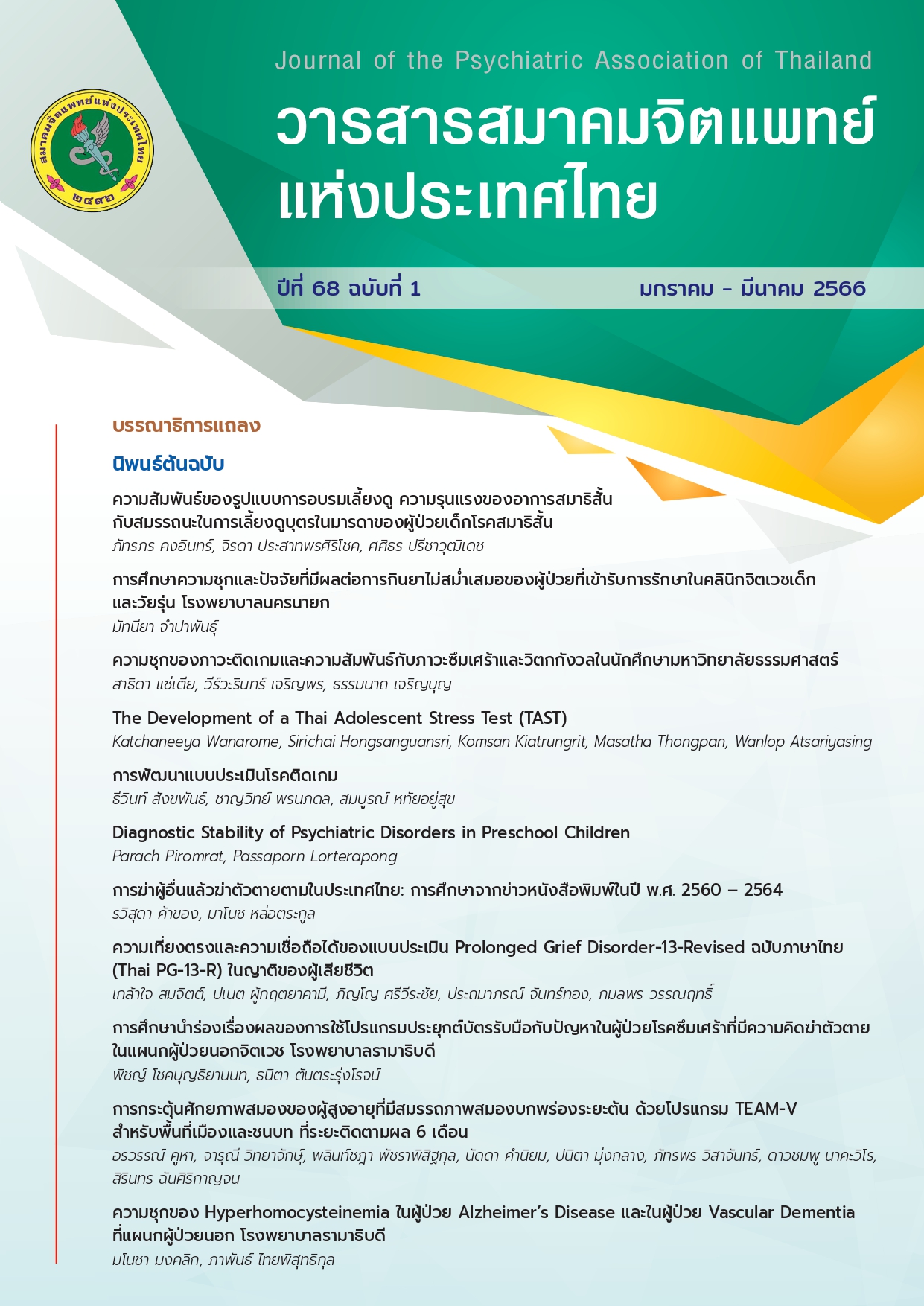Diagnostic Stability of Psychiatric Disorders in Preschool Children
Main Article Content
Abstract
Objective: To examine the stability of psychiatric disorders in preschoolers across time and to determine the factors associated with diagnostic stability.
Methods: This retrospective chart review was conducted on 256 children aged 3 to 5 years who received psychiatric evaluation at the Child and Adolescent Psychiatric Clinic and the Developmental and Behavioral Pediatric Clinic over a period of at least 2 years and had the last follow-up visit within the ages of 6 to 18 years.
Results: Only autism spectrum disorder (ASD) and attention-deficit/hyperactivity disorder (ADHD) showed statistical significance of good and fair diagnostic stability, respectively. Conditions unlisted in the Diagnostic and Statistical Manual of Mental Disorders, fifth edition (DSM-5) manual such as behavioral, child-rearing, emotional dysregulation, and writing problems, and also normal condition, had high transition rates to later ADHD. Living with parents, chief complaints, psychiatric comorbidity, medication use at the first visit, duration of follow-up and change of doctor over time were significantly associated with the stability of diagnoses.
Conclusions: Preschool ASD and ADHD seem more stable than other diagnoses and tend to co-occur with other conditions, suggesting that they are likely to continue and exhibit further problems. Clinicians should pay particular attention to early identification based on standardized diagnostic practices and consider the factors influencing dynamical changes in order to prevent future impairment.
Article Details

This work is licensed under a Creative Commons Attribution-NonCommercial-NoDerivatives 4.0 International License.
Articles submitted for consideration must not have been previously published or accepted for publication in any other journal, and must not be under review by any other journal.
References
Sadock BJ, Sadock VA, Ruiz P. Kaplan & Sadock's synopsis of psychiatry: Behavioral sciences/clinical psychiatry. 11th ed. Philadelphia: Wolters Kluwer; 2015.
Martin A, Bloch MH, Volkmar FR. Lewis’s child and adolescent psychiatry: A comprehensive textbook. 5th ed. Philadelphia: Wolters Kluwer; 2018.
Thapar A, Pine DS, Leckman JF, Scott S, Snowling MJ, Taylor E, editors. Rutter’s child and adolescent psychiatry. 6th ed. Chichester: John Wiley and Sons; 2015.
Mattanah JJ, Becker DF, Levy KN, Edell WS, McGlashan TH. Diagnostic stability in adolescents followed up 2 years after hospitalization. Am J Psychiatry 1995;152:889-94.
Whitty P, Clarke M, McTigue O, Browne S, Kamali M, Larkin C, et al. Diagnostic stability four years after a first episode of psychosis. Psychiatr Serv 2005;56:1084-8.
Baca-Garcia E, Perez-Rodriguez MM, Basurte-Villamor I, Fernandez del Moral AL, Jimenez-Arriero MA, Gonzalez de Rivera JL, et al. Diagnostic stability of psychiatric disorders in clinical practice. Br J Psychiatry 2007;190:210-6.
Dyrborg J, Wang AR. Adolescent psychiatric patients with child psychiatric debut: a description of diagnostic stability and change. Nordic Journal of Psychiatry 1997;51:153-8.
Ghazan-shahi S, Roberts N, Parker K. Stability/change of DSM diagnoses among children and adolescents assessed at a university hospital: a cross-sectional cohort study. J Can Acad Child Adolesc Psychiatry 2009;18:287-92.
Blázquez A, Ortiz AE, Castro-Fornieles J, Morer A, Baeza I, Martínez E, et al. Five-year diagnostic stability among adolescents in an inpatient psychiatric unit. Compr Psychiatry 2019;89:33-9.
Pettit JW, Morgan S, Paukert AL. The stability of axis I diagnoses in youth across multiple psychiatric hospitalizations. Child Psychiatry Hum Dev 2005;36:53-71.
Remberk B, Bogumił B, Namysłowska I. Retrospective analysis of the course of psychotic episodes in adolescent inpatients. Psychiatr Pol 2012;46:511-21.
Fusar-Poli P, Cappucciati M, Rutigliano G, Heslin M, Stahl D, Brittenden Z, et al. Diagnostic stability of ICD/DSM first episode psychosis diagnoses: meta-analysis. Schizophr Bull 2016;42:1395-406.
Consoli A, Brunelle J, Bodeau N, Louët E, Deniau E, Perisse D, et al. Diagnostic transition towards schizophrenia in adolescents with severe bipolar disorder type I: an 8-year follow-up study. Schizophr Res 2014;159:284-91.
Copeland WE, Adair CE, Smetanin P, Stiff D, Briante C, Colman I, et al. Diagnostic transitions from childhood to adolescence to early adulthood. J Child Psychol Psychiatry 2013;54:791-9.
Bufferd SJ, Dougherty LR, Carlson GA, Rose S, Klein DN. Psychiatric disorders in preschoolers: continuity from ages 3 to 6. Am J Psychiatry 2012;169:1157-64.
Costello EJ, Mustillo S, Erkanli A, Keeler G, Angold A. Prevalence and development of psychiatric disorders in childhood and adolescence. Arch Gen Psychiatry 2003;60:837-44.
Tandon M, Si X, Luby J. Preschool onset attention-deficit/hyperactivity disorder: course and predictors of stability over 24 months. J Child Adolesc Psychopharmacol 2011;21:321-30.
Hinnebusch AJ. The diagnostic stability of developmental delay and developmental language disorder in infants and toddlers. Uconn Library [Internet]. 2014 [cited 2022 Dec 10]. Available from: https://opencommons.uconn.edu/gs_theses/541
Ozonoff S, Young G, Landa R, Brian J, Bryson S, Charman T, et al. Diagnostic stability in young children at risk for autism spectrum disorder: a baby siblings research consortium study. J Child Psychol Psychiatry 2015;56. doi: 10.1111/jcpp.12421.
American Psychiatric Association. Diagnostic and statistical manual of mental disorders. 5th ed. Washington: American Psychiatric Publishing; 2013.
McHugh ML. Interrater reliability: the kappa statistic. Biochem Med 2012;22:276-82.
Kadam A, Patni B, Pandit A, Patole S. Stability of the initial diagnosis of autism spectrum disorder by DSM-5 in children: a short-term follow-up study. J Trop Pediatr 2021;67:1-6. doi: 10.1093/tropej/fmaa104.
Riddle MA, Yershova K, Lazzaretto D, Paykina N, Yenokyan G, Greenhill L, et al. The preschool attention-deficit/hyperactivity disorder treatment study (PATS) 6-year follow-up. J Am Acad Child Adolesc Psychiatry 2013;52:264-78.
Büber A, Başay Ö, Şenol H. The prevalence and comorbidity rates of specific learning disorder among primary school children in Turkey. Nord J Psychiatry 2020;74:453-60.
Craig F, Lamanna AL, Margari F, Matera E, Simone M, Margari L. Overlap between autism spectrum disorders and attention deficit hyperactivity disorder: searching for distinctive/common clinical features. Autism Res 2015;8:328-37.
Antshel KM, Russo N. Autism spectrum disorders and ADHD: overlapping phenomenology, diagnostic issues, and treatment considerations. Curr Psychiatry Rep 2019;21:34. doi: 10.1007/s11920-019-1020-5.
Hours C, Recasens C, Baleyte JM. ASD and ADHD comorbidity: what are we talking about?. Front Psychiatry 2022;13:837424. doi: 10.3389/fpsyt.2022.837424.


